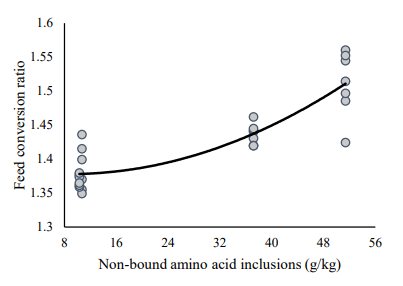I. Introduction
Wheat and sorghum are the two major feed grains used in Australia for broiler diets; however, wheat is more common and is usually considered better quality than sorghum. The local chicken meat industry may have to increase by 60% to meet demand in 2050 so strategies are needed to promote sustainable chicken-meat production to meet this anticipated demand. Crude protein reductions in broiler diets could be a major factor in the quest for sustainable production. Reduced-CP diets have the potential to lower nitrogen excretion and ammonia emissions, improve litter quality and bird welfare, and reduce our dependence on imported soybean meal. However, growth performance of broiler chickens is often compromised by reductions in dietary CP and growth response to reduction of dietary protein was inconsistent among different feed grains (Liu et al., 2021). Wheat-based, reduced-CP diets depressed broiler growth performance in Greenhalgh et al. (2020); in contrast, maize-based diets performed well when dietary CP was reduced (Chrystal et al. 2021). The protein structure and functional properties are similar in sorghum in comparison to maize, and sorghum contains less soluble non-starch polysaccharides and relatively slow starch digestion rate than wheat. Therefore, the present study was designed to compare wheat- and sorghum-based diets in the context of reduced CP diets.
II. Material and methods
This feeding study was conducted in compliance with the guidelines of the Animal Ethics Committee of The University of Sydney. A total of 392 off-sex, male Ross 308 broilers were randomly distributed into 28 floor pens with 14 birds per pen and 7 replicates for each treatment from 14-35 days post-hatch. Prior to this, birds were offered a commercial starter diet. Four experimental diets were formulated based on wheat and sorghum with 210 and 170 g/kg dietary CP concentrations (with xylanase and phytase). All diets were formulated to 13.0 MJ/kg energy and contain ideal amino acid ratios based on 11.0 g/kg digestible lysine. Growth performance, relative abdominal fat-pad weights and carcass traits were determined from 14 to 35 days posthatch. JMP Pro 14 was used to perform analyses of variance and a 5% probability level was considered significant.
Table 1 - Composition and nutrient specification of experimental diets
III. Results
The outcomes of this comparison are shown in Table 2, where overall growth performance exceeded 2019 Aviagen performance objectives for Ross 308 birds by 18.0% for weight gain, 6.50% for feed intake and by 9.49% for FCR. Dietary CP reduction compromised weight gain by 4.61% (2232 versus 2129 g/bird; P < 0.001), feed intake by 2.72% (3157 versus 3071; P = 0.031). Sorghum-based diets supported higher weight gains than wheat by 4.84% (2232 versus 2129 g/bird; P = 0.002). A significant treatment interaction (P = 0.033) was observed for FCR as broilers offered 210 g/kg CP wheat- and sorghum-based diets had statistically similar feed conversion ratios. In contrast, at 170 g/kg CP, the sorghum-based diet supported a better FCR than wheat by 4.90% (1.437 versus 1.511). Therefore, reducing dietary CP from 210 to 170 g/kg increased FCR in wheat and sorghum-based diets by 8.94% and 4.97%, respectively. Dietary CP reductions increased relative fat-pad weights by 16.7% (10.35 versus 8.34 g/kg/bird, P = 0.010) and sorghum-based diets generated heavier fat-pad weights than wheat by 31.8% (10.99 versus 8.34 g/kg/bird, P < 0.001). Dietary CP reduction generated lower relative breast weights by 4.82% (228 versus 217 g/kg/bird, P < 0.001) and wheat-based diets supported heavier breast weights than sorghum by 8.41% (232 versus 214 g/kg/bird, P = 0.004). Relative thigh weights were not influenced (P > 0.15) by treatment.
Table 2 - Growth performance and carcass traits from 14 to 35 days post-hatch
IV. Discussion
The interaction between dietary CP and feed grain on FCR, where sorghum enjoyed a 4.90% advantage in 170 g/kg CP diets, suggests that sorghum is superior to wheat as the basis of reduced-CP broiler diets. Alternatively, sorghum generated 42.1% heavier fat-pad weights than broilers offered 170 g/kg CP, wheat-based diets, which is disadvantageous. These conflicting outcomes present a conundrum to the development of reduced-CP broiler diets.
In reduced-CP diets, wheat seems to have a lesser propensity to increase abdominal fatpad weights, and by extension overall fat deposition, than maize (Chrystal et al., 2021) and, in the present study, sorghum. It is probably salient that the starch digestion rate of wheat is more rapid than maize or sorghum which has been demonstrated under in vitro (Giuberti et al., 2012) and in vivo (Selle et al., 2021) conditions. It appears that slowly digestible maize and sorghum starch and the more gradual and sustained intestinal uptakes of glucose promotes increased fat deposition via de novo lipogenesis (Wang et al., 2017). Excess glucose may be stored as glycogen in liver and muscle but the capacity of avian species to store glycogen in muscle is limited (Braun and Sweazea, 2008). Once glycogen stores are saturated glucose is effectively converted into fat by de novo lipogenesis in the liver. On the other hand, glucose from rapidly digestible wheat starch may be disposed of by direct oxidation to greater extents (Jequier, 1994).
The wheat-based, 170 g/kg CP diet contained substantially more non-bound amino acids (51.4 versus 37.2 g/kg) than the corresponding sorghum-based diet. The genesis of this difference was simply because the protein content of wheat exceeded that of sorghum. Nonbound amino acids are more rapidly absorbed than protein-bound amino acids and it follows that this difference could trigger post-enteral amino acid imbalances resulting in the deamination of surplus amino acids and excretion of uric acid, a process that requires energy (Selle et al., 2020). The balance between non-bound and protein-bound amino acids in reduced-CP diets may be pivotal, as discussed by Macelline et al. (2020), and a point may be reached where non-bound amino acid inclusions become excessive and compromise performance. In the present study, for example, dietary non-bound amino acid inclusions compromised FCR in a quadratic manner (r = 0.882, P < 0.001), as shown in Figure 1.
Figure 1 Quadratic relationship (r = 0.882; P < 0.001) between dietary non-bound amino acid inclusions and FCR in broiler chickens y = 1.383 - 0.001*NBAA + 0.00007263*NBAA2
V. Conclusions
Broiler responses to wheat- and sorghum-based diets containing 170 g/kg CP were divergent in that sorghum generated better efficiency of feed conversion but somewhat paradoxically, with greater fat deposition. In this and other comparative studies, the impact that the feed grain selected as the basis of a reduced-CP diets has on broiler performance is of tremendous importance. The genesis of these differences between feed grains appears to be related to both the properties of starch and protein contents, which dictate the extent of non-bound amino acid inclusions. A better comprehension of both factors is needed if reduced-CP broiler diets are to be developed successfully.
Presented at the 33th Annual Australian Poultry Science Symposium 2022. For information on the next edition, click here. 


















